Comprehensive Review: Class V Mathematics Curriculum Project
VerifiedAdded on 2023/01/16
|11
|3113
|81
Report
AI Summary
This report offers a detailed review of a Class V mathematics curriculum, focusing on its reconstruction and evaluation. The analysis begins with an introduction to curriculum change and its importance in education, followed by an examination of the CIPP model as the preferred theoretical foundation. The report then explores preferred design and development models, including instructional design models and the current curriculum model, and how they are applied in the context of the Class V mathematics curriculum. The curriculum's context, subject outlines, learning outcomes, and teaching methodologies are discussed, highlighting the strands of numeracy, operations, patterns, measurement, geometry, data management, and probability. The report also covers student participation, assessment methods, and the importance of teacher leadership in curriculum reconstruction. The reflection and conclusion summarize the key findings and emphasize the significance of teacher knowledge and communication skills in facilitating effective curriculum implementation, referencing the importance of the CIPP and instructional design models.
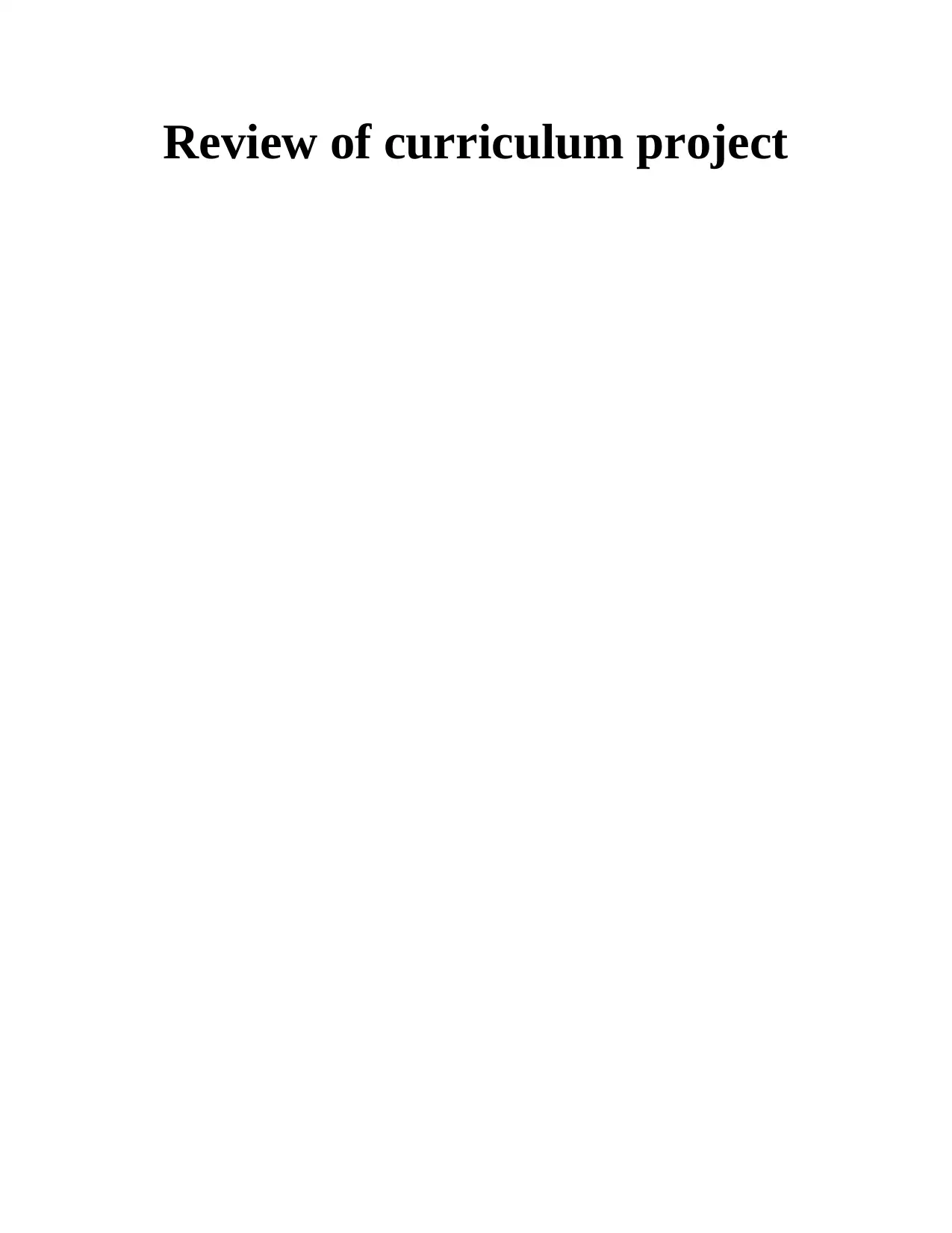
Review of curriculum project
Paraphrase This Document
Need a fresh take? Get an instant paraphrase of this document with our AI Paraphraser

Table of Contents
Introduction......................................................................................................................................1
Preferred Theoretical Foundations – CIPP Model for Curriculum Evaluation...............................1
Preferred Design and development models.....................................................................................2
Instructional Design Model.........................................................................................................2
Current Curriculum Model..........................................................................................................3
Reconstructing Curriculum in Context............................................................................................3
Subject Outline and learning outcomes...........................................................................................4
Subject teaching and learning, Student participation and assessment.............................................5
Subject teaching...............................................................................................................................6
Reflection and Conclusion...............................................................................................................6
REFERENCES................................................................................................................................8
Introduction......................................................................................................................................1
Preferred Theoretical Foundations – CIPP Model for Curriculum Evaluation...............................1
Preferred Design and development models.....................................................................................2
Instructional Design Model.........................................................................................................2
Current Curriculum Model..........................................................................................................3
Reconstructing Curriculum in Context............................................................................................3
Subject Outline and learning outcomes...........................................................................................4
Subject teaching and learning, Student participation and assessment.............................................5
Subject teaching...............................................................................................................................6
Reflection and Conclusion...............................................................................................................6
REFERENCES................................................................................................................................8

⊘ This is a preview!⊘
Do you want full access?
Subscribe today to unlock all pages.

Trusted by 1+ million students worldwide
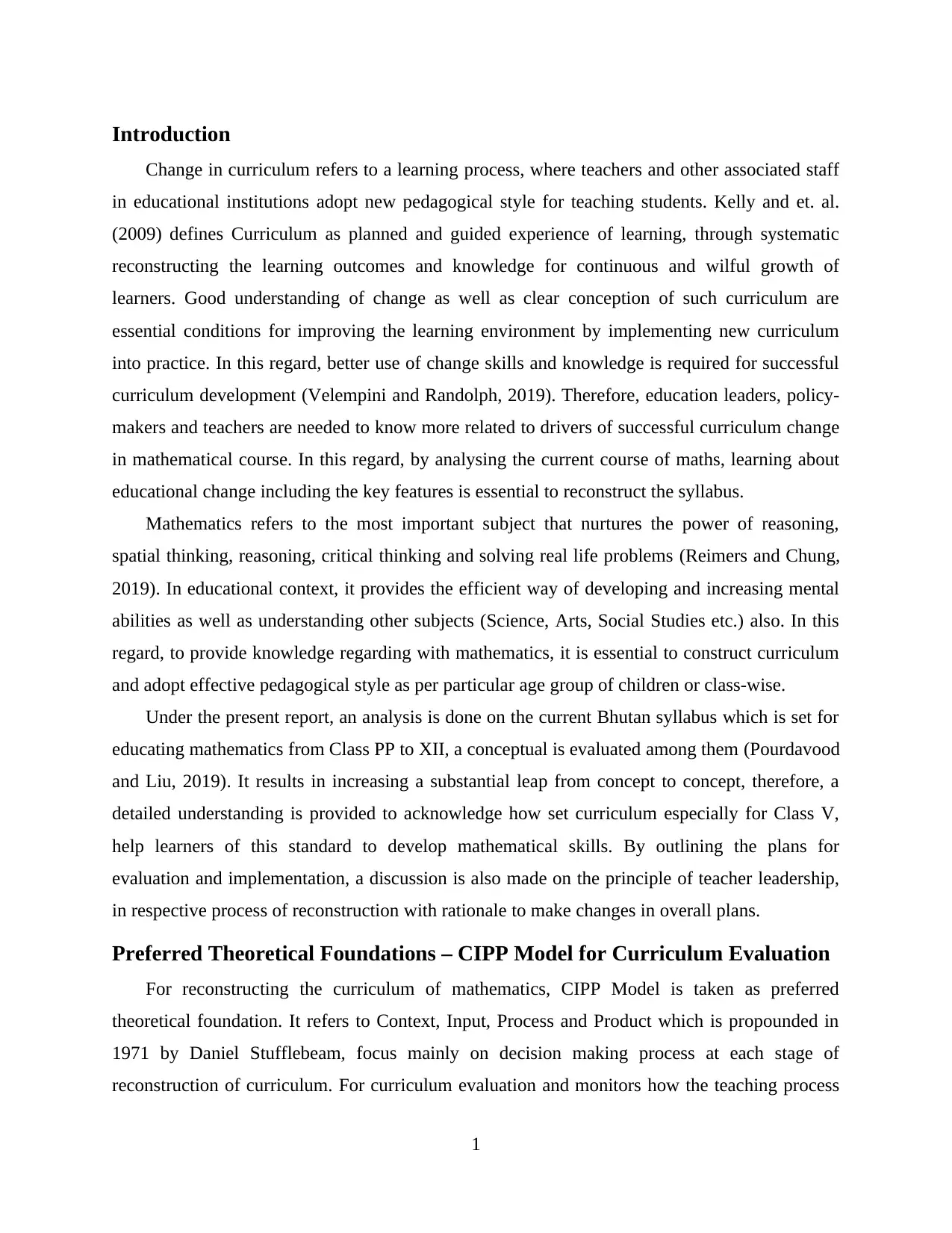
Introduction
Change in curriculum refers to a learning process, where teachers and other associated staff
in educational institutions adopt new pedagogical style for teaching students. Kelly and et. al.
(2009) defines Curriculum as planned and guided experience of learning, through systematic
reconstructing the learning outcomes and knowledge for continuous and wilful growth of
learners. Good understanding of change as well as clear conception of such curriculum are
essential conditions for improving the learning environment by implementing new curriculum
into practice. In this regard, better use of change skills and knowledge is required for successful
curriculum development (Velempini and Randolph, 2019). Therefore, education leaders, policy‐
makers and teachers are needed to know more related to drivers of successful curriculum change
in mathematical course. In this regard, by analysing the current course of maths, learning about
educational change including the key features is essential to reconstruct the syllabus.
Mathematics refers to the most important subject that nurtures the power of reasoning,
spatial thinking, reasoning, critical thinking and solving real life problems (Reimers and Chung,
2019). In educational context, it provides the efficient way of developing and increasing mental
abilities as well as understanding other subjects (Science, Arts, Social Studies etc.) also. In this
regard, to provide knowledge regarding with mathematics, it is essential to construct curriculum
and adopt effective pedagogical style as per particular age group of children or class-wise.
Under the present report, an analysis is done on the current Bhutan syllabus which is set for
educating mathematics from Class PP to XII, a conceptual is evaluated among them (Pourdavood
and Liu, 2019). It results in increasing a substantial leap from concept to concept, therefore, a
detailed understanding is provided to acknowledge how set curriculum especially for Class V,
help learners of this standard to develop mathematical skills. By outlining the plans for
evaluation and implementation, a discussion is also made on the principle of teacher leadership,
in respective process of reconstruction with rationale to make changes in overall plans.
Preferred Theoretical Foundations – CIPP Model for Curriculum Evaluation
For reconstructing the curriculum of mathematics, CIPP Model is taken as preferred
theoretical foundation. It refers to Context, Input, Process and Product which is propounded in
1971 by Daniel Stufflebeam, focus mainly on decision making process at each stage of
reconstruction of curriculum. For curriculum evaluation and monitors how the teaching process
1
Change in curriculum refers to a learning process, where teachers and other associated staff
in educational institutions adopt new pedagogical style for teaching students. Kelly and et. al.
(2009) defines Curriculum as planned and guided experience of learning, through systematic
reconstructing the learning outcomes and knowledge for continuous and wilful growth of
learners. Good understanding of change as well as clear conception of such curriculum are
essential conditions for improving the learning environment by implementing new curriculum
into practice. In this regard, better use of change skills and knowledge is required for successful
curriculum development (Velempini and Randolph, 2019). Therefore, education leaders, policy‐
makers and teachers are needed to know more related to drivers of successful curriculum change
in mathematical course. In this regard, by analysing the current course of maths, learning about
educational change including the key features is essential to reconstruct the syllabus.
Mathematics refers to the most important subject that nurtures the power of reasoning,
spatial thinking, reasoning, critical thinking and solving real life problems (Reimers and Chung,
2019). In educational context, it provides the efficient way of developing and increasing mental
abilities as well as understanding other subjects (Science, Arts, Social Studies etc.) also. In this
regard, to provide knowledge regarding with mathematics, it is essential to construct curriculum
and adopt effective pedagogical style as per particular age group of children or class-wise.
Under the present report, an analysis is done on the current Bhutan syllabus which is set for
educating mathematics from Class PP to XII, a conceptual is evaluated among them (Pourdavood
and Liu, 2019). It results in increasing a substantial leap from concept to concept, therefore, a
detailed understanding is provided to acknowledge how set curriculum especially for Class V,
help learners of this standard to develop mathematical skills. By outlining the plans for
evaluation and implementation, a discussion is also made on the principle of teacher leadership,
in respective process of reconstruction with rationale to make changes in overall plans.
Preferred Theoretical Foundations – CIPP Model for Curriculum Evaluation
For reconstructing the curriculum of mathematics, CIPP Model is taken as preferred
theoretical foundation. It refers to Context, Input, Process and Product which is propounded in
1971 by Daniel Stufflebeam, focus mainly on decision making process at each stage of
reconstruction of curriculum. For curriculum evaluation and monitors how the teaching process
1
Paraphrase This Document
Need a fresh take? Get an instant paraphrase of this document with our AI Paraphraser

is going on, four main phases of this model is applied. It includes Context Evaluation for
determining objectives behind setting curriculum as per class; Input Evaluation for ascertaining
program design set to provide knowledge to students; Process Evaluation to develop control for
program operations; and last phase is Product Evaluation for judging and reacting to program
attainments (Jarrah, Khasawneh and Wardat, 2020). Therefore, this model helps in determining
the degree at which objectives of education are going to achieve. Along with this, during
development of programs, improvement in case of necessity can be made to ensure that set goals
can be achieved.
Figure 1: CIPP Model
Preferred Design and development models
For reconstructing the present curriculum of mathematics for Class V, it is essential to take
under consideration the design as well as development models. For this purpose, Instructional
design models and curriculum development models are used for reconstructing and redesigning
the curriculum.
Instructional Design Model
This models helps in developing guidelines for organising appropriate and systematic
pedagogical style and approaches for achievement of curriculum objectives. Instruction design
model is mainly used for conducting practice to create learning experience, by facilitating better
environment. Using this model, well-defined goals can be set which is essential for developing
better pedagogical. Along with this, as respective design model focuses on performance level
therefore, it helps in building desired behaviour under pupils, which is expected to them to
sustain a good life.
2
determining objectives behind setting curriculum as per class; Input Evaluation for ascertaining
program design set to provide knowledge to students; Process Evaluation to develop control for
program operations; and last phase is Product Evaluation for judging and reacting to program
attainments (Jarrah, Khasawneh and Wardat, 2020). Therefore, this model helps in determining
the degree at which objectives of education are going to achieve. Along with this, during
development of programs, improvement in case of necessity can be made to ensure that set goals
can be achieved.
Figure 1: CIPP Model
Preferred Design and development models
For reconstructing the present curriculum of mathematics for Class V, it is essential to take
under consideration the design as well as development models. For this purpose, Instructional
design models and curriculum development models are used for reconstructing and redesigning
the curriculum.
Instructional Design Model
This models helps in developing guidelines for organising appropriate and systematic
pedagogical style and approaches for achievement of curriculum objectives. Instruction design
model is mainly used for conducting practice to create learning experience, by facilitating better
environment. Using this model, well-defined goals can be set which is essential for developing
better pedagogical. Along with this, as respective design model focuses on performance level
therefore, it helps in building desired behaviour under pupils, which is expected to them to
sustain a good life.
2
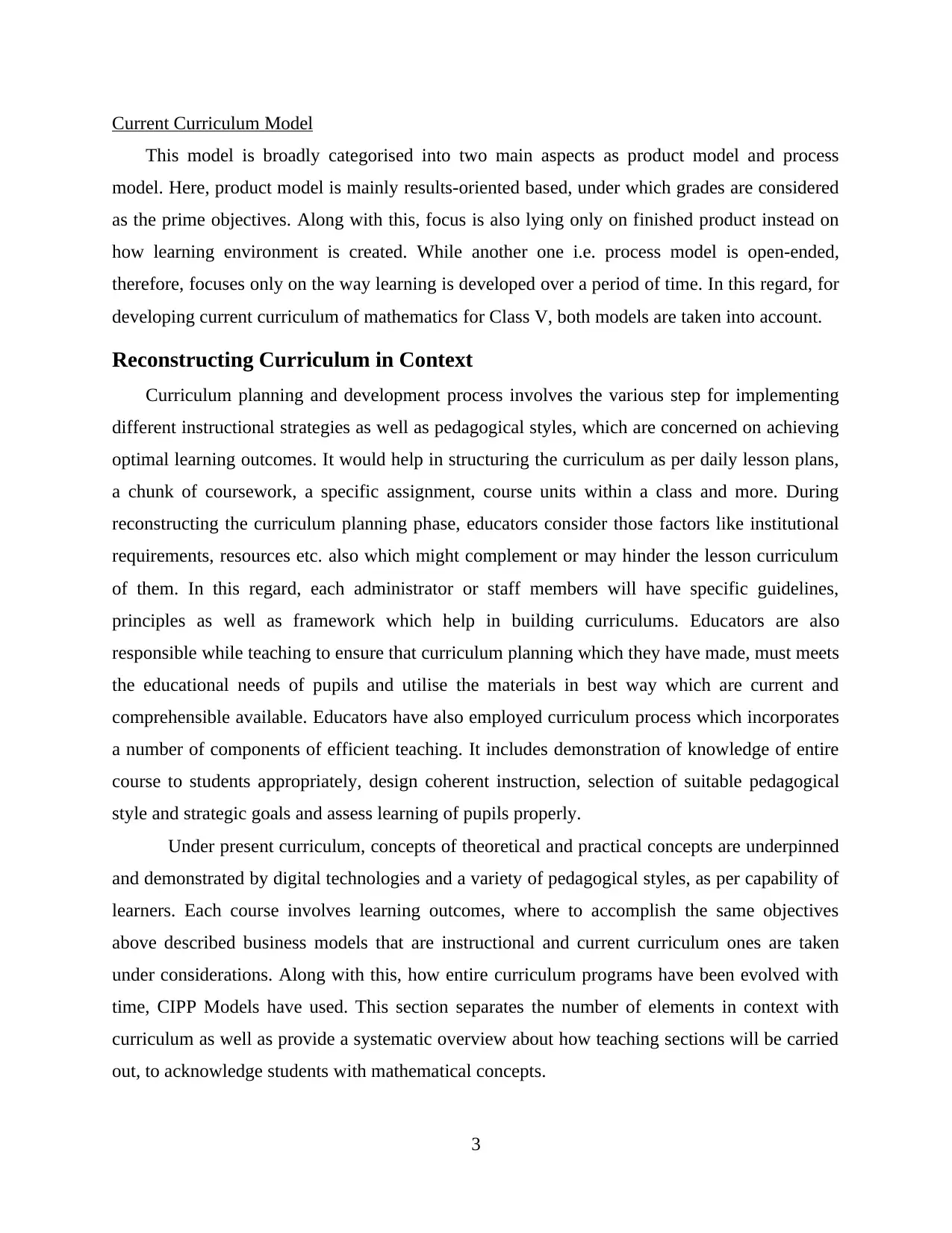
Current Curriculum Model
This model is broadly categorised into two main aspects as product model and process
model. Here, product model is mainly results-oriented based, under which grades are considered
as the prime objectives. Along with this, focus is also lying only on finished product instead on
how learning environment is created. While another one i.e. process model is open-ended,
therefore, focuses only on the way learning is developed over a period of time. In this regard, for
developing current curriculum of mathematics for Class V, both models are taken into account.
Reconstructing Curriculum in Context
Curriculum planning and development process involves the various step for implementing
different instructional strategies as well as pedagogical styles, which are concerned on achieving
optimal learning outcomes. It would help in structuring the curriculum as per daily lesson plans,
a chunk of coursework, a specific assignment, course units within a class and more. During
reconstructing the curriculum planning phase, educators consider those factors like institutional
requirements, resources etc. also which might complement or may hinder the lesson curriculum
of them. In this regard, each administrator or staff members will have specific guidelines,
principles as well as framework which help in building curriculums. Educators are also
responsible while teaching to ensure that curriculum planning which they have made, must meets
the educational needs of pupils and utilise the materials in best way which are current and
comprehensible available. Educators have also employed curriculum process which incorporates
a number of components of efficient teaching. It includes demonstration of knowledge of entire
course to students appropriately, design coherent instruction, selection of suitable pedagogical
style and strategic goals and assess learning of pupils properly.
Under present curriculum, concepts of theoretical and practical concepts are underpinned
and demonstrated by digital technologies and a variety of pedagogical styles, as per capability of
learners. Each course involves learning outcomes, where to accomplish the same objectives
above described business models that are instructional and current curriculum ones are taken
under considerations. Along with this, how entire curriculum programs have been evolved with
time, CIPP Models have used. This section separates the number of elements in context with
curriculum as well as provide a systematic overview about how teaching sections will be carried
out, to acknowledge students with mathematical concepts.
3
This model is broadly categorised into two main aspects as product model and process
model. Here, product model is mainly results-oriented based, under which grades are considered
as the prime objectives. Along with this, focus is also lying only on finished product instead on
how learning environment is created. While another one i.e. process model is open-ended,
therefore, focuses only on the way learning is developed over a period of time. In this regard, for
developing current curriculum of mathematics for Class V, both models are taken into account.
Reconstructing Curriculum in Context
Curriculum planning and development process involves the various step for implementing
different instructional strategies as well as pedagogical styles, which are concerned on achieving
optimal learning outcomes. It would help in structuring the curriculum as per daily lesson plans,
a chunk of coursework, a specific assignment, course units within a class and more. During
reconstructing the curriculum planning phase, educators consider those factors like institutional
requirements, resources etc. also which might complement or may hinder the lesson curriculum
of them. In this regard, each administrator or staff members will have specific guidelines,
principles as well as framework which help in building curriculums. Educators are also
responsible while teaching to ensure that curriculum planning which they have made, must meets
the educational needs of pupils and utilise the materials in best way which are current and
comprehensible available. Educators have also employed curriculum process which incorporates
a number of components of efficient teaching. It includes demonstration of knowledge of entire
course to students appropriately, design coherent instruction, selection of suitable pedagogical
style and strategic goals and assess learning of pupils properly.
Under present curriculum, concepts of theoretical and practical concepts are underpinned
and demonstrated by digital technologies and a variety of pedagogical styles, as per capability of
learners. Each course involves learning outcomes, where to accomplish the same objectives
above described business models that are instructional and current curriculum ones are taken
under considerations. Along with this, how entire curriculum programs have been evolved with
time, CIPP Models have used. This section separates the number of elements in context with
curriculum as well as provide a systematic overview about how teaching sections will be carried
out, to acknowledge students with mathematical concepts.
3
⊘ This is a preview!⊘
Do you want full access?
Subscribe today to unlock all pages.

Trusted by 1+ million students worldwide
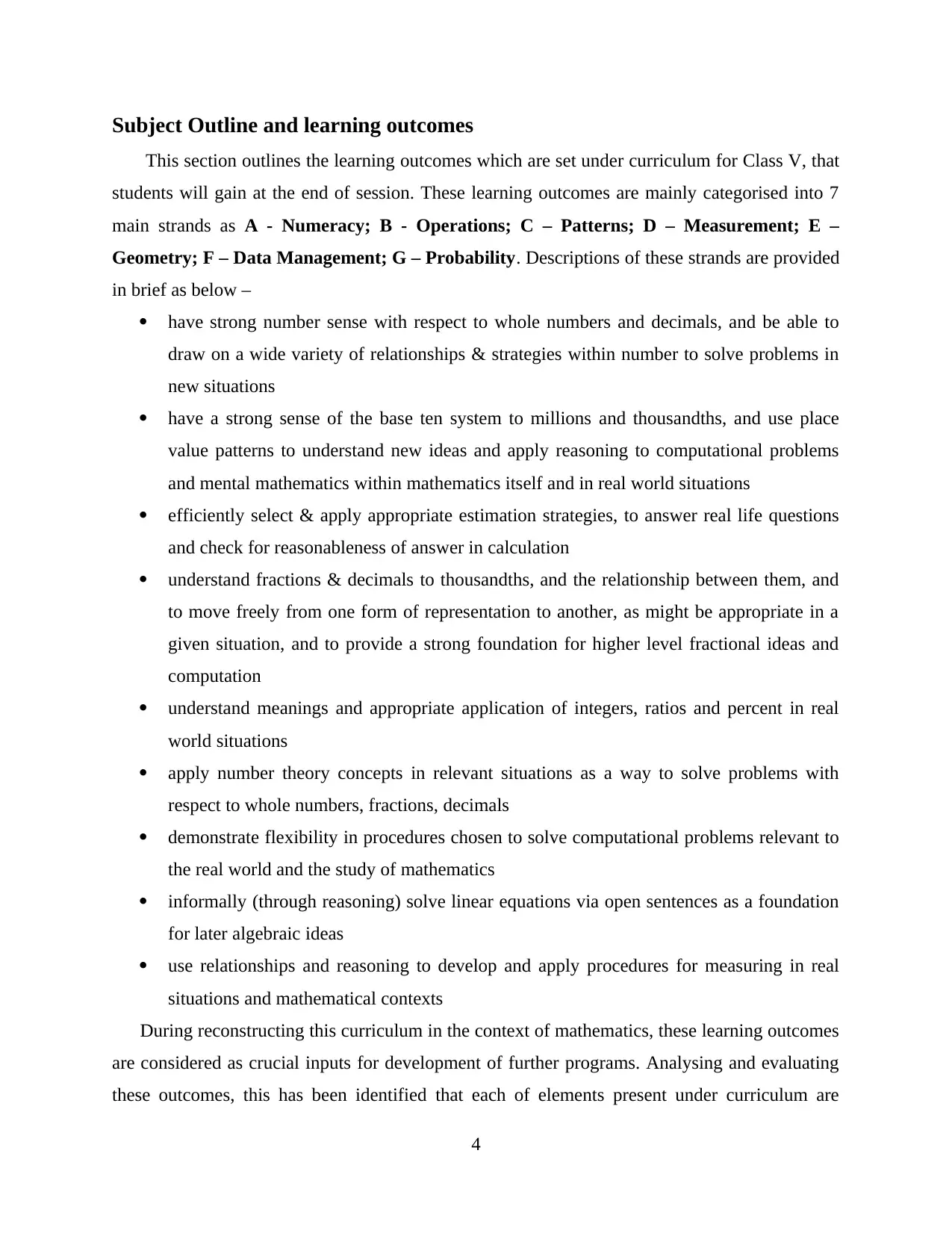
Subject Outline and learning outcomes
This section outlines the learning outcomes which are set under curriculum for Class V, that
students will gain at the end of session. These learning outcomes are mainly categorised into 7
main strands as A - Numeracy; B - Operations; C – Patterns; D – Measurement; E –
Geometry; F – Data Management; G – Probability. Descriptions of these strands are provided
in brief as below –
have strong number sense with respect to whole numbers and decimals, and be able to
draw on a wide variety of relationships & strategies within number to solve problems in
new situations
have a strong sense of the base ten system to millions and thousandths, and use place
value patterns to understand new ideas and apply reasoning to computational problems
and mental mathematics within mathematics itself and in real world situations
efficiently select & apply appropriate estimation strategies, to answer real life questions
and check for reasonableness of answer in calculation
understand fractions & decimals to thousandths, and the relationship between them, and
to move freely from one form of representation to another, as might be appropriate in a
given situation, and to provide a strong foundation for higher level fractional ideas and
computation
understand meanings and appropriate application of integers, ratios and percent in real
world situations
apply number theory concepts in relevant situations as a way to solve problems with
respect to whole numbers, fractions, decimals
demonstrate flexibility in procedures chosen to solve computational problems relevant to
the real world and the study of mathematics
informally (through reasoning) solve linear equations via open sentences as a foundation
for later algebraic ideas
use relationships and reasoning to develop and apply procedures for measuring in real
situations and mathematical contexts
During reconstructing this curriculum in the context of mathematics, these learning outcomes
are considered as crucial inputs for development of further programs. Analysing and evaluating
these outcomes, this has been identified that each of elements present under curriculum are
4
This section outlines the learning outcomes which are set under curriculum for Class V, that
students will gain at the end of session. These learning outcomes are mainly categorised into 7
main strands as A - Numeracy; B - Operations; C – Patterns; D – Measurement; E –
Geometry; F – Data Management; G – Probability. Descriptions of these strands are provided
in brief as below –
have strong number sense with respect to whole numbers and decimals, and be able to
draw on a wide variety of relationships & strategies within number to solve problems in
new situations
have a strong sense of the base ten system to millions and thousandths, and use place
value patterns to understand new ideas and apply reasoning to computational problems
and mental mathematics within mathematics itself and in real world situations
efficiently select & apply appropriate estimation strategies, to answer real life questions
and check for reasonableness of answer in calculation
understand fractions & decimals to thousandths, and the relationship between them, and
to move freely from one form of representation to another, as might be appropriate in a
given situation, and to provide a strong foundation for higher level fractional ideas and
computation
understand meanings and appropriate application of integers, ratios and percent in real
world situations
apply number theory concepts in relevant situations as a way to solve problems with
respect to whole numbers, fractions, decimals
demonstrate flexibility in procedures chosen to solve computational problems relevant to
the real world and the study of mathematics
informally (through reasoning) solve linear equations via open sentences as a foundation
for later algebraic ideas
use relationships and reasoning to develop and apply procedures for measuring in real
situations and mathematical contexts
During reconstructing this curriculum in the context of mathematics, these learning outcomes
are considered as crucial inputs for development of further programs. Analysing and evaluating
these outcomes, this has been identified that each of elements present under curriculum are
4
Paraphrase This Document
Need a fresh take? Get an instant paraphrase of this document with our AI Paraphraser

coincided with description of curriculum. The outcomes that are highlighted as above are also
taken as main goals which educators of primary classes are expected from students of Class V to
reach, to get promoted in next class. Along with this, Considering the curriculum set for 5th
Standard students, it has analysed that policy makers wish that at the end of session, students will
become able to possess appropriate knowledge of basic mathematics. The curriculum they have
set will definitely aid learners of this class to have number sense especially with respect to real
numbers like whole numbers and decimals (Amin, Kalsoom and Islam, 2019). They will
definitely become able to draw on a large variety of relationships as well as strategies in number
to solve the complex problems.
Subject teaching and learning, Student participation and assessment
This section of present curriculum of mathematics highlights how participation of each
student will be taken and engage them within set activities, for achievement of learning
outcomes. Furthermore, an explanation about type of mathematical activities which will happen
during class is also made. In this regard, both lectures and tutorials, with digital classes are
selected as primary mathematical activities, with co-curriculum programs to make students
familiar with set knowledge of maths. Within newly reconstructed curriculum, it is pointed out
that the first part A Strand – Numbers is divided into ten sections from A1 to A10. But in this
process, first part i.e. A1 is directly start with Factors – With Whole Numbers, so a little bit
change is required. Because it is essential for teachers to remind learners firstly about what is
whole numbers as A0 – Revision of Whole Numbers, which includes how it is different from
other real numbers. Including this topic as priority, will help learners to understand further topics
of whole numbers like factors, millions, comparison and others. Now, the next topic in
mathematics for 5th Standard is set as – B Strand Operations, the specific outcomes that will
obtain after teaching this subject includes – solving the computational problems. It includes
concept of whole numbers and decimals via selection of appropriate operations and procedures
like computation, estimation and mental math (Antony‐Newman, 2019). Under this process,
teachers will provide the methods of computation as per different-different situations, such as
pencil/paper, mental math, estimation, technology etc. To evaluate if entire set activities are
properly done and learning outcomes are achieved, students’ performance will be evaluated after
completion of each strands. For this purpose, some assessments will be provided to students with
5
taken as main goals which educators of primary classes are expected from students of Class V to
reach, to get promoted in next class. Along with this, Considering the curriculum set for 5th
Standard students, it has analysed that policy makers wish that at the end of session, students will
become able to possess appropriate knowledge of basic mathematics. The curriculum they have
set will definitely aid learners of this class to have number sense especially with respect to real
numbers like whole numbers and decimals (Amin, Kalsoom and Islam, 2019). They will
definitely become able to draw on a large variety of relationships as well as strategies in number
to solve the complex problems.
Subject teaching and learning, Student participation and assessment
This section of present curriculum of mathematics highlights how participation of each
student will be taken and engage them within set activities, for achievement of learning
outcomes. Furthermore, an explanation about type of mathematical activities which will happen
during class is also made. In this regard, both lectures and tutorials, with digital classes are
selected as primary mathematical activities, with co-curriculum programs to make students
familiar with set knowledge of maths. Within newly reconstructed curriculum, it is pointed out
that the first part A Strand – Numbers is divided into ten sections from A1 to A10. But in this
process, first part i.e. A1 is directly start with Factors – With Whole Numbers, so a little bit
change is required. Because it is essential for teachers to remind learners firstly about what is
whole numbers as A0 – Revision of Whole Numbers, which includes how it is different from
other real numbers. Including this topic as priority, will help learners to understand further topics
of whole numbers like factors, millions, comparison and others. Now, the next topic in
mathematics for 5th Standard is set as – B Strand Operations, the specific outcomes that will
obtain after teaching this subject includes – solving the computational problems. It includes
concept of whole numbers and decimals via selection of appropriate operations and procedures
like computation, estimation and mental math (Antony‐Newman, 2019). Under this process,
teachers will provide the methods of computation as per different-different situations, such as
pencil/paper, mental math, estimation, technology etc. To evaluate if entire set activities are
properly done and learning outcomes are achieved, students’ performance will be evaluated after
completion of each strands. For this purpose, some assessments will be provided to students with
5
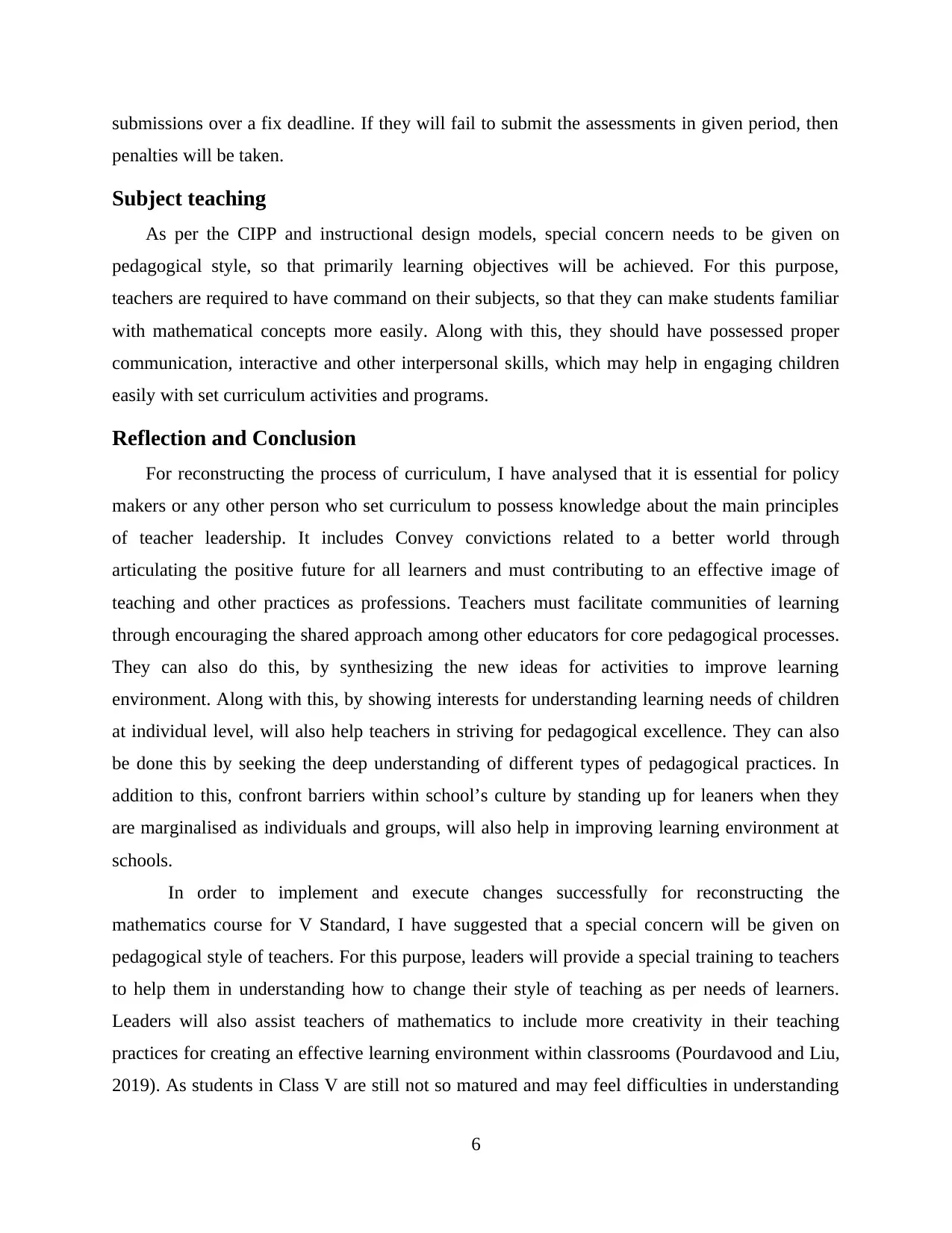
submissions over a fix deadline. If they will fail to submit the assessments in given period, then
penalties will be taken.
Subject teaching
As per the CIPP and instructional design models, special concern needs to be given on
pedagogical style, so that primarily learning objectives will be achieved. For this purpose,
teachers are required to have command on their subjects, so that they can make students familiar
with mathematical concepts more easily. Along with this, they should have possessed proper
communication, interactive and other interpersonal skills, which may help in engaging children
easily with set curriculum activities and programs.
Reflection and Conclusion
For reconstructing the process of curriculum, I have analysed that it is essential for policy
makers or any other person who set curriculum to possess knowledge about the main principles
of teacher leadership. It includes Convey convictions related to a better world through
articulating the positive future for all learners and must contributing to an effective image of
teaching and other practices as professions. Teachers must facilitate communities of learning
through encouraging the shared approach among other educators for core pedagogical processes.
They can also do this, by synthesizing the new ideas for activities to improve learning
environment. Along with this, by showing interests for understanding learning needs of children
at individual level, will also help teachers in striving for pedagogical excellence. They can also
be done this by seeking the deep understanding of different types of pedagogical practices. In
addition to this, confront barriers within school’s culture by standing up for leaners when they
are marginalised as individuals and groups, will also help in improving learning environment at
schools.
In order to implement and execute changes successfully for reconstructing the
mathematics course for V Standard, I have suggested that a special concern will be given on
pedagogical style of teachers. For this purpose, leaders will provide a special training to teachers
to help them in understanding how to change their style of teaching as per needs of learners.
Leaders will also assist teachers of mathematics to include more creativity in their teaching
practices for creating an effective learning environment within classrooms (Pourdavood and Liu,
2019). As students in Class V are still not so matured and may feel difficulties in understanding
6
penalties will be taken.
Subject teaching
As per the CIPP and instructional design models, special concern needs to be given on
pedagogical style, so that primarily learning objectives will be achieved. For this purpose,
teachers are required to have command on their subjects, so that they can make students familiar
with mathematical concepts more easily. Along with this, they should have possessed proper
communication, interactive and other interpersonal skills, which may help in engaging children
easily with set curriculum activities and programs.
Reflection and Conclusion
For reconstructing the process of curriculum, I have analysed that it is essential for policy
makers or any other person who set curriculum to possess knowledge about the main principles
of teacher leadership. It includes Convey convictions related to a better world through
articulating the positive future for all learners and must contributing to an effective image of
teaching and other practices as professions. Teachers must facilitate communities of learning
through encouraging the shared approach among other educators for core pedagogical processes.
They can also do this, by synthesizing the new ideas for activities to improve learning
environment. Along with this, by showing interests for understanding learning needs of children
at individual level, will also help teachers in striving for pedagogical excellence. They can also
be done this by seeking the deep understanding of different types of pedagogical practices. In
addition to this, confront barriers within school’s culture by standing up for leaners when they
are marginalised as individuals and groups, will also help in improving learning environment at
schools.
In order to implement and execute changes successfully for reconstructing the
mathematics course for V Standard, I have suggested that a special concern will be given on
pedagogical style of teachers. For this purpose, leaders will provide a special training to teachers
to help them in understanding how to change their style of teaching as per needs of learners.
Leaders will also assist teachers of mathematics to include more creativity in their teaching
practices for creating an effective learning environment within classrooms (Pourdavood and Liu,
2019). As students in Class V are still not so matured and may feel difficulties in understanding
6
⊘ This is a preview!⊘
Do you want full access?
Subscribe today to unlock all pages.

Trusted by 1+ million students worldwide

concepts of mathematics. Therefore, for this purpose, teachers must include the different
methods of teaching like SMART Classes, will help in engaging learners more easily. Along
with this, taking short review test before and after teaching a topic, will aid teachers to judge
mental abilities of each learner in classroom, so that improvement in practices can be made
accordingly (Reimers and Chung, 2019). For reforming the plans as described above, a proper
report will be prepared first to give attention of policy makers who have set the current plans of
mathematics especially for Class V, about mistakes that have made. By describing them about
how some mistakes will affect the set specific outcomes that they wished to receive after ending
of session. In addition to this, how small changes will help in reducing the occurrence of same,
will also aid in implementing and executing the described changes successfully.
7
methods of teaching like SMART Classes, will help in engaging learners more easily. Along
with this, taking short review test before and after teaching a topic, will aid teachers to judge
mental abilities of each learner in classroom, so that improvement in practices can be made
accordingly (Reimers and Chung, 2019). For reforming the plans as described above, a proper
report will be prepared first to give attention of policy makers who have set the current plans of
mathematics especially for Class V, about mistakes that have made. By describing them about
how some mistakes will affect the set specific outcomes that they wished to receive after ending
of session. In addition to this, how small changes will help in reducing the occurrence of same,
will also aid in implementing and executing the described changes successfully.
7
Paraphrase This Document
Need a fresh take? Get an instant paraphrase of this document with our AI Paraphraser
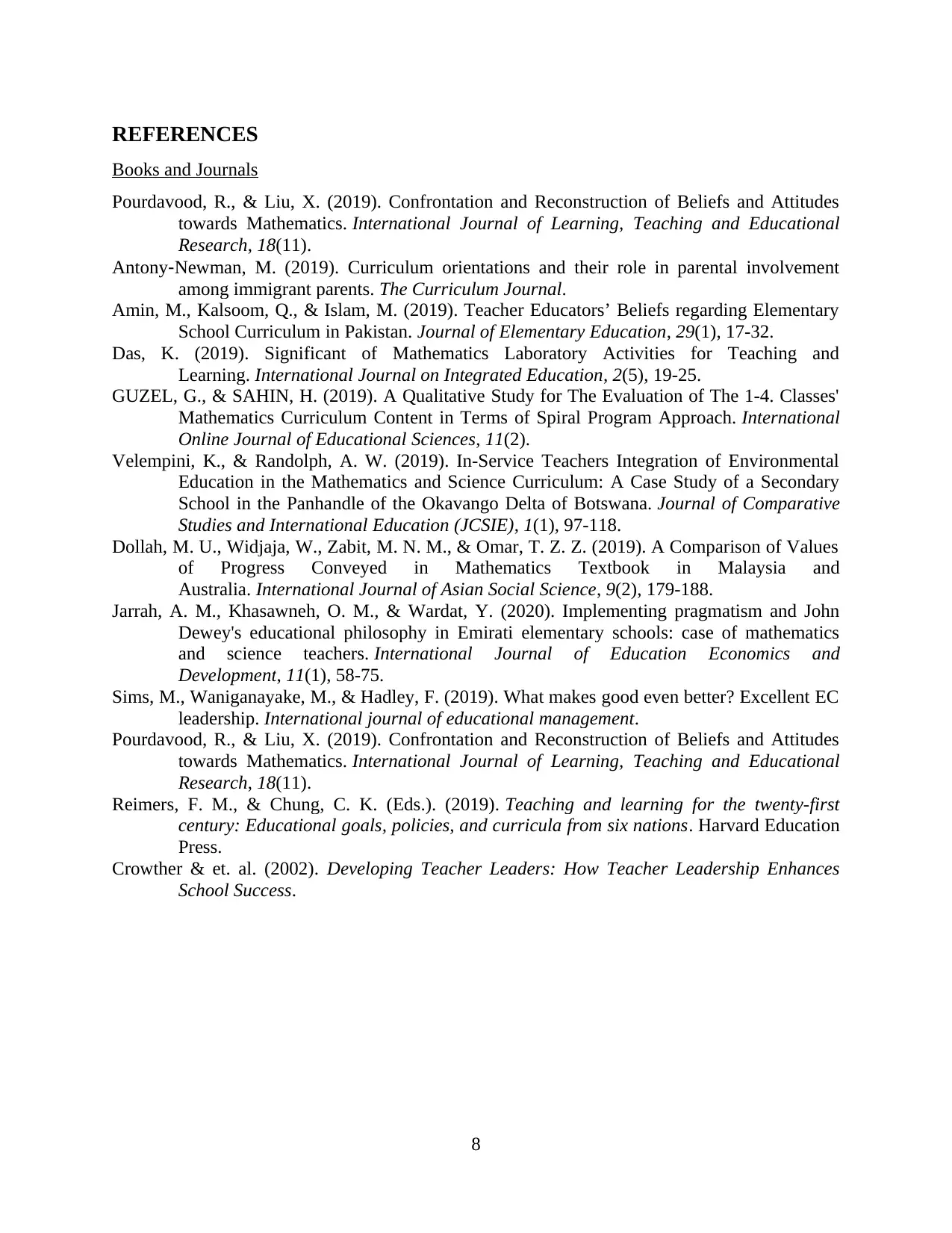
REFERENCES
Books and Journals
Pourdavood, R., & Liu, X. (2019). Confrontation and Reconstruction of Beliefs and Attitudes
towards Mathematics. International Journal of Learning, Teaching and Educational
Research, 18(11).
Antony‐Newman, M. (2019). Curriculum orientations and their role in parental involvement
among immigrant parents. The Curriculum Journal.
Amin, M., Kalsoom, Q., & Islam, M. (2019). Teacher Educators’ Beliefs regarding Elementary
School Curriculum in Pakistan. Journal of Elementary Education, 29(1), 17-32.
Das, K. (2019). Significant of Mathematics Laboratory Activities for Teaching and
Learning. International Journal on Integrated Education, 2(5), 19-25.
GUZEL, G., & SAHIN, H. (2019). A Qualitative Study for The Evaluation of The 1-4. Classes'
Mathematics Curriculum Content in Terms of Spiral Program Approach. International
Online Journal of Educational Sciences, 11(2).
Velempini, K., & Randolph, A. W. (2019). In-Service Teachers Integration of Environmental
Education in the Mathematics and Science Curriculum: A Case Study of a Secondary
School in the Panhandle of the Okavango Delta of Botswana. Journal of Comparative
Studies and International Education (JCSIE), 1(1), 97-118.
Dollah, M. U., Widjaja, W., Zabit, M. N. M., & Omar, T. Z. Z. (2019). A Comparison of Values
of Progress Conveyed in Mathematics Textbook in Malaysia and
Australia. International Journal of Asian Social Science, 9(2), 179-188.
Jarrah, A. M., Khasawneh, O. M., & Wardat, Y. (2020). Implementing pragmatism and John
Dewey's educational philosophy in Emirati elementary schools: case of mathematics
and science teachers. International Journal of Education Economics and
Development, 11(1), 58-75.
Sims, M., Waniganayake, M., & Hadley, F. (2019). What makes good even better? Excellent EC
leadership. International journal of educational management.
Pourdavood, R., & Liu, X. (2019). Confrontation and Reconstruction of Beliefs and Attitudes
towards Mathematics. International Journal of Learning, Teaching and Educational
Research, 18(11).
Reimers, F. M., & Chung, C. K. (Eds.). (2019). Teaching and learning for the twenty-first
century: Educational goals, policies, and curricula from six nations. Harvard Education
Press.
Crowther & et. al. (2002). Developing Teacher Leaders: How Teacher Leadership Enhances
School Success.
8
Books and Journals
Pourdavood, R., & Liu, X. (2019). Confrontation and Reconstruction of Beliefs and Attitudes
towards Mathematics. International Journal of Learning, Teaching and Educational
Research, 18(11).
Antony‐Newman, M. (2019). Curriculum orientations and their role in parental involvement
among immigrant parents. The Curriculum Journal.
Amin, M., Kalsoom, Q., & Islam, M. (2019). Teacher Educators’ Beliefs regarding Elementary
School Curriculum in Pakistan. Journal of Elementary Education, 29(1), 17-32.
Das, K. (2019). Significant of Mathematics Laboratory Activities for Teaching and
Learning. International Journal on Integrated Education, 2(5), 19-25.
GUZEL, G., & SAHIN, H. (2019). A Qualitative Study for The Evaluation of The 1-4. Classes'
Mathematics Curriculum Content in Terms of Spiral Program Approach. International
Online Journal of Educational Sciences, 11(2).
Velempini, K., & Randolph, A. W. (2019). In-Service Teachers Integration of Environmental
Education in the Mathematics and Science Curriculum: A Case Study of a Secondary
School in the Panhandle of the Okavango Delta of Botswana. Journal of Comparative
Studies and International Education (JCSIE), 1(1), 97-118.
Dollah, M. U., Widjaja, W., Zabit, M. N. M., & Omar, T. Z. Z. (2019). A Comparison of Values
of Progress Conveyed in Mathematics Textbook in Malaysia and
Australia. International Journal of Asian Social Science, 9(2), 179-188.
Jarrah, A. M., Khasawneh, O. M., & Wardat, Y. (2020). Implementing pragmatism and John
Dewey's educational philosophy in Emirati elementary schools: case of mathematics
and science teachers. International Journal of Education Economics and
Development, 11(1), 58-75.
Sims, M., Waniganayake, M., & Hadley, F. (2019). What makes good even better? Excellent EC
leadership. International journal of educational management.
Pourdavood, R., & Liu, X. (2019). Confrontation and Reconstruction of Beliefs and Attitudes
towards Mathematics. International Journal of Learning, Teaching and Educational
Research, 18(11).
Reimers, F. M., & Chung, C. K. (Eds.). (2019). Teaching and learning for the twenty-first
century: Educational goals, policies, and curricula from six nations. Harvard Education
Press.
Crowther & et. al. (2002). Developing Teacher Leaders: How Teacher Leadership Enhances
School Success.
8
1 out of 11
Related Documents
Your All-in-One AI-Powered Toolkit for Academic Success.
+13062052269
info@desklib.com
Available 24*7 on WhatsApp / Email
![[object Object]](/_next/static/media/star-bottom.7253800d.svg)
Unlock your academic potential
Copyright © 2020–2025 A2Z Services. All Rights Reserved. Developed and managed by ZUCOL.





